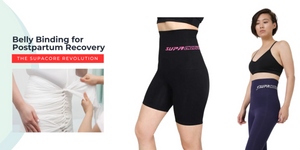The internet was all a buzz when Kim Kardashian supposedly ate her placenta.
Jessica Alba , Gwyneth Paltrow and Elle Macpherson practised the ancient art of Belly binding.
Elle has her own belly binder in residence.
Belly binding has not been a passing celebrity fad.

This ancient practice that has been used by post natal women across various cultures for centuries. It involves wrapping a long piece of cloth around the abdomen after childbirth to provide support and aid in the healing process. While the exact origins of belly binding are difficult to pinpoint, it has been practiced in various forms in cultures such as Indonesian, Malaysian, African, and Latin American.
Aboriginal elders are supposed to have used warm paperbark tightened around the abdomen.
Science tells that at the use of belly binding has it positive benefits;
• Support the abdominal muscles which have been weakened during pregnancy and childbirth.
• Helping the uterus return to its pre-pregnancy size more quickly.
• Reducing postpartum swelling and fluid retention.
• Providing comfort and a sense of security to the new mother.
• Improving posture and helping to alleviate lower back pain.
At Supacore we understand the science of belly binding well. It has been a time honored tradition for many cultures for centuries providing comfort and relief to postpartum mothers.
However technology, manufacturing and fashion has evolved over the years.
So has methods of post-partum support.
With the aid of specialist physiotherapist Dr Carolyn Taylor, the Supacore tech team have revolutionized postpartum support and are the go to choice for new mothers.
The team developed and range of innovative patented postpartum shorts and leggings – a modern, functional and convenient alternative to belly banding.
The Supacore Difference
Supacore's postpartum shorts and leggings are designed with a patented cutting-edge waistband technology, body mapped medical compression a unique Ribtech® technology which provides the muscles with a gentle massage.
This technology offers offer several advantages over traditional belly binding methods:
1. Targeted Compression: Supacore's patented CORETECH™ technology provides targeted compression to the lower back, pelvis, and abdominal muscles, offering support where it's needed most. This helps alleviate pain, reduce swelling, and promote faster recovery.2. Seamless Design: Unlike traditional belly binding, which can be bulky and uncomfortable, Supacore's postpartum garments feature a seamless design that ensures a smooth and comfortable fit. This allows new mothers to wear them discreetly under clothing, making them a practical choice for everyday use.
3. Medical-Grade Compression: Supacore's postpartum shorts and leggings are made with medical-grade compression , which has been proven to aid in postpartum recovery by improving blood circulation, reducing swelling, and providing support to weakened muscles.
4. Easy to Use: Traditional belly binding can be complicated and time-consuming to apply correctly. In contrast, Supacore's postpartum garments are easy to put on and take off, making them a convenient option for busy new mothers.
5. Versatility: Supacore's postpartum shorts and leggings can be worn during various activities, from light exercise to daily errands, providing continuous support throughout the day.
6. Stylish and Functional: Supacore's postpartum garments are not only functional but also fashionable, allowing new mothers to feel confident and stylish while benefiting from the support they provide.

|
 |
|
PATENTED CHARLOTTE CORETECH® INJURY RECOVERY / POSTPARTUM 7/8 LEGGING WITH POCKET |
PATENTED MARY WOMEN'S CORETECH® INJURY RECOVERY AND POSTPARTUM COMPRESSION SHORTS |
Supacore's postpartum shorts and leggings have emerged as a modern innovation and an effective alternative to traditional belly binding, offering new mothers the support they need during their postnatal recovery. With targeted compression, seamless design, and medical-grade materials, these garments provide the perfect combination of comfort, style, and functionality.
Brown, C. J., & Noelle, G. (2010). The use of abdominal binders to treat overdistended abdominal muscles in a woman 6 months postpartum. Journal of Women's Health Physical Therapy, 34(3), 105-111. Link: https://journals.lww.com/jwhpt/Abstract/2010/09000/The_Use_of_Abdominal_Binders_to_Treat.7.aspx
Partsch, H., Clark, M., Bassez, S., Benigni, J. P., Becker, F., Blazek, V., ... & Flour, M. (2008). Measurement of lower leg compression in vivo: recommendations for the performance of measurements of interface pressure and stiffness: consensus statement. Dermatologic surgery, 34(2), 224-232. Link: https://onlinelibrary.wiley.com/doi/full/10.1111/j.1524-4725.2007.34053.x
- Hill, J., Howatson, G., van Someren, K., Leeder, J., & Pedlar, C. (2014). Compression garments and recovery from exercise-induced muscle damage: a meta-analysis. British Journal of Sports Medicine, 48(18), 1340-1346. Link: https://bjsm.bmj.com/content/48/18/1340

